The official consultation on the draft Loch Lomond and Trossachs National Park Partnership Plan (NPPP) 2018-23 closes on Monday 3rd July. The NPPP is the key document governing what the LLTNPA is supposed to do over the next five years so its important people respond. In this post I will take an overview of the consultation documents and then, in three further posts, will consider the three themes in the consultation, Conservation and Land Management, Rural Development and Visitor Experience, which broadly mirror the National Park’s statutory objectives. I hope people with an interest in our National Parks will respond to the consultation and that these posts may inform those responses. Its easy to be cynical about consultations, and I believe the LLTNPA consultation demonstrates just how hollowed out consultation processes have become, but public pressure does work. A good example is the pledge which was added to the Cairngorms National Park Partnership Plan to eliminate raptor persecution over the next five years. Pressure needs to be exerted on the LLTNPA to radically up its game.
Where is the review of the current NPPP?
A rational starting point for developing any new plan should be a review of existing plans, covering matters such as successes, failures and consideration as to what needs to change. The current NPPP, 2012-17, was initially reviewed on an annual basis, at a meeting chaired by the Environment Minister. The Reviews are available on the LLTNPA website NPPPlan but you will never come across these if you go straight to the consultation pages and there is no mention of them in the consultation documents nor is there any explanation of why the last one was in 2014. Had the reviews been undertaken as originally intended, the information from them could have been fed into the new planning process. Instead, publicly at least, there is a huge hole.
What the last review in 2014 does show is that the LLTNPA was facing certain serious issues and was lacking data on critical issues.
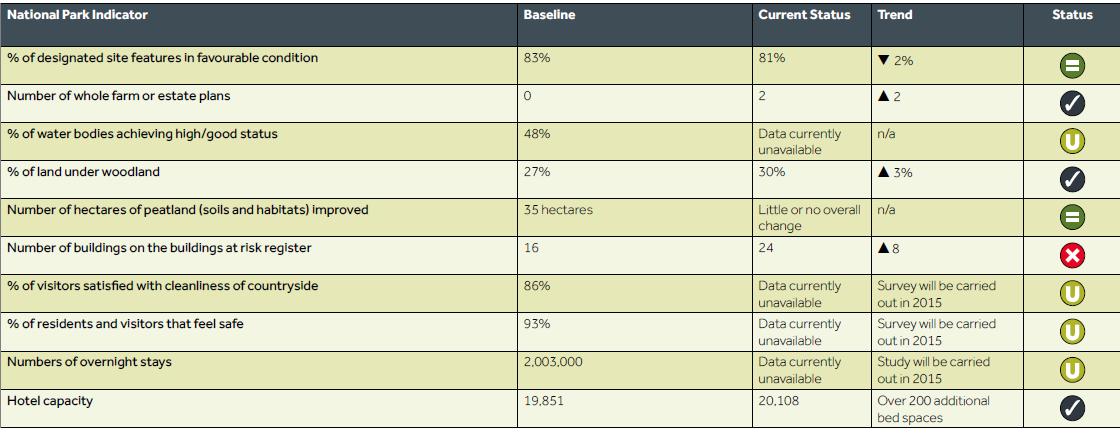
Note how the LLTNPA classed a drop in percentage of designated conservation sites in favourable conditions with an “equals” symbol, meaning there was nothing to worry about. And, were the LLTNPA to have collected data on % of visitors satisfied with cleanliness of the countryside I suspect there would have been a massive drop from 86%. This raises the question about whether the LLTNPA is now simply operating in a post-truth environment, that its not collecting and reporting data because it would not support its marketing hype. Other measures from 2013-14 were even worse: a drop in the percentage of new affordable housing from a baseline of 75% to 43% and a drop in new business start ups.
Where is the consultation on the issues the LLTNPA is facing?
The consultation documents do not ask people to consider the issues the National Park faces, quite a contrast to the Cairngorms National Park Authority consultation which was based around “The Big 9” issues they had identified. The only place that there is any consideration of the issues is in the Strategic Environment Assessment which most people won’t read as nowhere in the consultation does it suggest this might be worth reading. I can see why, because the SEA explains how the consultation should have been undertaken:

An outcomes based plan
Instead of considering the evidence and what issues it faces the draft NPPP starts and ends with a consideration of outcomes. It appears that what is driving this is the Scottish Government’s National Outcome framework.
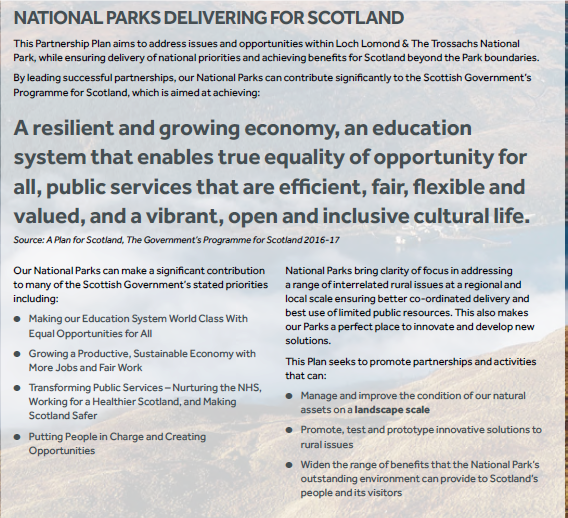
While our National Parks can contribute to some national outcomes, actually that’s not their primary purpose, which is to meet their statutory objectives. The Plan though, instead of considering how it can meet those statutory objectives, is full of meaningless claims to be contributing to certain outcomes.

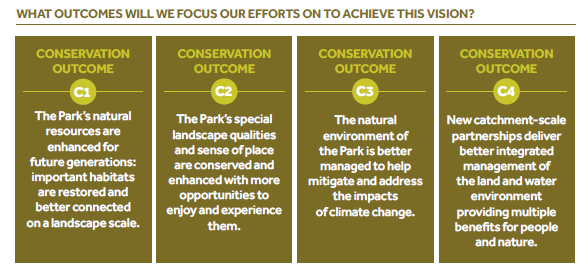
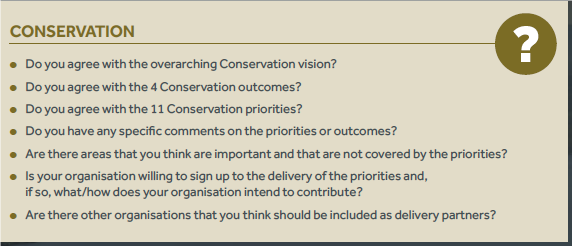
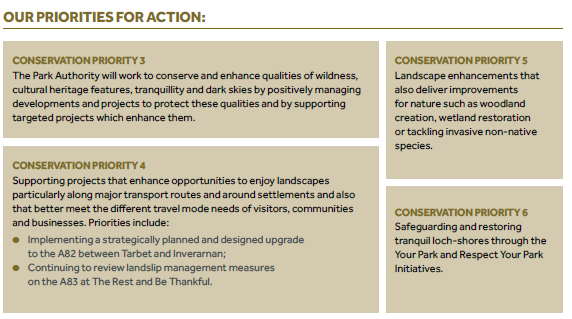
The secret and biased consultation process
“The close of the year saw the Board approve our new draft National Park Partnership Plan 2018-23 for consultation following a hugely positive workshop with a wide range of stakeholders to discuss important issues and potential priorities. This presented an opportunity to reflect on the achievements of the current plan.
To this end, a comprehensive discussion paper was developed and a day-long event was held for partners that have a role to play in the delivery of the new Plan”
So why is the comprehensive discussion paper not public and why has the LLTNPA not told the public what it believes these achievements were? (I have asked for these to be made public immediately).
What I do know is that the LLTNPA selected the invitees to the consultation meeting very carefully and the range of “stakeholders” was limited: recreational and other organisations were not invited to the main workshop though there was a later briefing. No wonder the NPPP gives no consideration to issues like the destruction of landscape and failures in conservation in the National Park.
Nowhere in the NPPP are the organisations which represent people who visit the National Park treated as partners or even key stakeholders. A fundamental failing – although of course the glossy brochure is full of photos of the people such organisations represent.
How does the NPPP fit with other Strategies and Policies?
Unlike the Cairngorms NPPP, which attempted to describe how their NPPP fitted with out plans that had been agreed for the area, the LLTNPA makes almost no mention of other local plans or targets and how they might feed into the NPPP. There are references to national plans and strategies, but generally this is again at a very high level and so broad as to be meaningless.
Part of the issue is that the LLTNPA has far fewer plans and strategies than the CNPA and those that it does have tend to be focussed on developments (Callander and Balloch). It does though have a biodiversity plan, Wild Park 2012 (see here) with lots of detailed actions and targets. How this fits with the NPPP, how its informed priorities and whether the LLTNPA is committed to a new biodversity action plan is unclear.
The draft NPPP would have us believe it is joined up to everything when the reality is it appears joined up to almost nothing and practically empty of real commitments from either the LLTNPA or the organisations it has identified as its partners.
Not all of this is the fault of the LLTNPA, much comes down to austerity – our public authorities are no longer being allowed to plan to do things which could improve everyone’s lives. But in my view our National Park Authorities out loud about resources, not just for themselves but for other partners, if any of its statutory objectives are to be achieved.
What needs to happen
People and organisations need to put pressure on the LLTNPA and the Scottish Government. A good start would be to respond to the NPPP objecting to the failure by the LLTNPA to review progress under the existing NPPP, consider the multitude of information about what is actually going on in the Park and the serious issues it faces. People should then use that reality to inform what issues they would like the LLTNPA to address in the new plan.
The LLTNPA needs to ensure that the new NPPP is based on a proper analysis of the evidence it holds and needs to take a critical look at how its being doing in relation to its statutory objectives.
I will cover the detail of this in posts over the next 10 days.
I think the first paragraph of the introduction to the national Park Partnership Plan 2018 – 2023 says it all when senior management go out of their way to distance themselves from failing to deliver outcomes of the current 2012 -2017 partnership plan by using weasel words. Quote:
“Our last National Park Partnership Plan 2012-2017 aimed to develop the potential of the National Park to be a “generator for growth in Scotland and a showcase for the very best of the scenery and natural heritage that Scotland is famous for.” Over the past five years we have worked “to increase the quality of the public infrastructure in the National Park to generate greater business activity to meet the Scottish Government’s core purpose of creating a more successful country through increasing sustainable economic growth.”
I contacted the planning department for clarification so I could make an informed response to the Draft Partnership Plan Consultation, I was told the annual partnership plan reports were discontinued in 2014 and absorbed into the more general annual reports, which are of course are devoid of all meaningful data on failures while heartily celebrating some achievements.
Having been forcibly diverted to the governance manager Amanda Aikmen, I was then directed to the soon to be obsolete “A Plan for Scotland 2016 – 2017 and two other plans 2016 – 2017 and 2017 – 2018 Operational Plans, the point being of course they are all plans and fail to give any details of achieved outcomes. The National Park Authority obviously do not wish to provide any information that could define a baseline for the next five year Draft Partnership Plan 2018 – 2023.
I believe it is an absolute necessity that this baseline is established before adoption of the draft plan otherwise no effective reporting can be achieved going forward relying instead in the now common anecdotal evidence the Park Board values as opposed to the reality of fact, maintaining their option for plausible deniability.
Further the knowledge of the current status is essential to make informed comment in the consultation process and the Park Authority are denying the public the opportunity to do so.